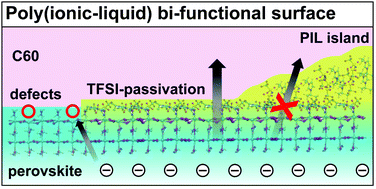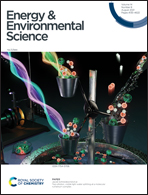Bi-functional interfaces by poly(ionic liquid) treatment in efficient pin and nip perovskite solar cells†
Abstract
Approaches to boost the efficiency and stability of perovskite solar cells often address one singular problem in a specific device configuration. In this work, we utilize a poly(ionic liquid) (PIL) to introduce a multi-functional interlayer to improve the device efficiency and stability for different perovskite compositions and architectures. The presence of the PIL at the perovskite surface reduces the non-radiative losses down to 60 meV already in the neat material, indicating effective surface trap passivation, thereby pushing the external photoluminescence quantum yield up to 7%. In devices, the PIL treatment induces a bi-functionality of the surface where insulating areas act as a blocking layer reducing interfacial charge recombination and increasing the VOC, whereas, at the same time, the passivated neighbouring regions provide more efficient charge extraction, increasing the FF. As a result, these solar cells exhibit outstanding VOC and FF values of 1.17 V and 83% respectively, with the best devices reaching conversion efficiencies up to 21.4%. The PIL-treated devices additionally show enhanced stability during maximum power point tracking (>700 h) and unchanged efficiencies after 10 months of shelf storage. By applying the PIL to small and wide bandgap perovskites, and to nip cells, we corroborate the generality of this methodology to improve the efficiency in various cell architectures and perovskite compositions.



 Please wait while we load your content...
Please wait while we load your content...